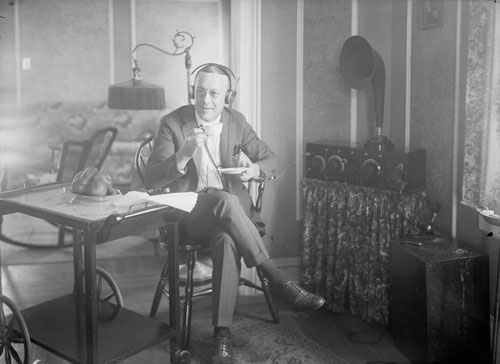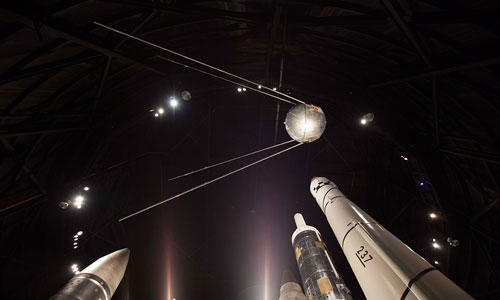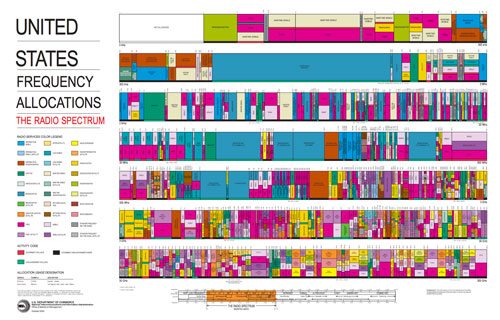The Invisible Puzzle
Wireless spectrum is scarce, and while mobile providers have made a sport of grabbing as much as they can, the fact is, allocating it has always been hard.
Editor's note: Thanks to everyone who was nice enough to buy a T-shirt or tote bag in support of Tedium over the last week. I realize that was a big ask, and I hope you enjoy your purchase in the coming weeks!
1927
The year that the Federal Radio Commission was first created. The body, which provided the roots of the modern-day Federal Communications Commission, came about due to the Radio Act of 1927, a law enacted after it became clear that the Commerce Department had no real control over radio licensing. In its initial annual report, the FRC noted the complexities of the radio spectrum were often underestimated by the public. “The act embraces the whole field of radio communication, but public interest was concentrated almost wholly on the single section of it devoted to radio broadcasting,” the report stated.

Ernest Hare an early Vaudeville star, listens to the radio in the 1920s. (infrogmation/Flickr)
What crowded the wireless spectrum before smartphones, anyway?
The fact of the matter is that we have always have trouble allocating spectrum in the right places, in part because there’s only so much of it, and there’s always some random use case that we haven’t thought of.
In the 1920s, for example, major newspapers like The New York Times would rely on shortwave radio waves, and news groups called on the Federal Radio Commission to ensure that their access to their access to shortwave radio lines would continue unabated.
(Yes, this was an important use for news-gathering back in the day, at least for the Times.)
A 1950 article from Associated Press science writer Wayne Oliver spoke of the broad spectrum needs of the radio airwaves, “which includes television, short wave, transatlantic telephone, ship-to-shore, mobile telephone, wireless telegraphy, radar, and a host of other services.” (Yes, there were actually mobile phones at the time, generally in cars.) But the biggest space hog is the one that was getting most of the attention at the time:
Of all these, television takes up by far the most space on the radio spectrum. That’s because of the tremendous number of impulses required to produce television’s 30 pictures a second.
The engineers speak of it in terms of “information.” The more information you have to transmit, the more space you take up on the air—the more the traffic the wider the highway has to be.
And of course, the fact that the United States isn’t the only country with spectrum needs, and there are parts of the airwaves that need to work between countries, such as shortwave radio, or maritime communication. An FCC report from 1949 lays out the depth of the issue:
The development of FM and TV broadcasting, the rapid growth of land mobile communication, the inauguration of microwave links for general radio communication relaying, the increasing use of electronic aids to air and sea navigation, and the expansion of Government radio services have all contributed to problems of frequency allocation in the upper part of the radio spectrum.
And, as the ether becomes more congested, interference grows in seriousness. That is why mutual working arrangements are being put into effect, not only between services, but between nations.
The international aspect of radio has developed to such an extent that the primary allocation of frequencies must now be made by treaty or other agreement. This will permit maximum radio use with minimum interference.
The burgeoning satellite industry complicated things further still. In a 1959 syndicated column on the issue, Dr. I.M. Levitt, the director of Philadelphia’s Franklin Planetarium Institute (and an early innovator on the subject of Martian time), raised concerns from Andrew G. Haley, the president of the International Astronautical Federation, that an array of “baby” satellites would threaten the radio spectrum in the years to come, due to said satellites being put into the air without a way to turn them off.

A Sputnik satellite, which some scientists found annoying due to its impact on the radio spectrum. (National Museum of the U.S. Air Force)
“While the sputniks were in the sky the 20 and 40 megacycle bands were useless for certain periods of time. They have since been silenced. But as we have seen, the 108 megacycle band is cluttered up and will remain so for two centuries,” Levitt wrote.
The satellite industry obviously evolved from there, pumping ever-more-sophisticated things through the spectrum—you know, like consumer internet, but also way beyond consumer internet. Ships need an easy way to communicate with the shore and to navigate the oceans. Astronomers need a way to see into space. And amateur radio operators deserve a spot in the spectrum, too.
Now take this already complicated state of affairs and add a whole bunch of smartphones to it.
“I thought Armstrong would invent some kind of a filter to remove static from our AM radio. I didn't think he'd start a revolution—start up a whole damn new industry to compete with RCA.”
— David Sarnoff, the longtime head of RCA, discussing his frustration with the then-burgeoning FM radio standard discovered by Edwin Armstrong and patented by the inventor in 1933. Armstrong’s innovation, which wasn’t compatible with Sarnoff’s existing AM radio system, was seen as a threat to RCA’s profits. In 1945, Sarnoff used his political clout to push the FCC to shift of the FM radio system to a different part of the spectrum, rendering all existing FM equipment obsolete and hurting its initial growth in the market. Armstrong, as pointed out by Damn Interesting, died in 1954 penniless, believing that he was a failure—but just a few years later, FM technology became the standard and Armstrong’s widow was successfully suing RCA and other companies for patent infringement.

The wireless spectrum is like the worst Lego puzzle you've ever seen. (markusspiske/Pixabay)
The complicated map that lays out the myriad uses for wireless spectrum
Imagine, if you will, the world’s biggest Lego structure. There are a ton of blocks, and everyone wants one. Some of the blocks matter to just a few people. Others matter to just about everyone.
And there are certain “load-bearing” blocks that simply have to be there, that can’t move or something important will break. They’re glued into their current position, and moving them is going to be incredibly difficult.
But the problem is, there are some new blocks that are suddenly incredibly valuable, that need to get in—and it’s your job to figure out how exactly to do that, without knocking anything out of place, or at least putting much care into the blocks you are trying to remove.
That’s the game of Jenga the FCC has long been playing with the wireless spectrum. Just check out this chart of frequency allocations, if you don’t believe me:
The full, zoomable version is over here, and a detailed breakdown of what’s in all those blocks, roughly, is over here. Go ahead, read it. We’ll be here next week when you’re done.
Does this puzzle look confusing? Just imagine the number of agreements, treaties, deals, and back-and-forth debating that went on over the past 90 or so years to get all of these spectrum blocks in place.
Along with how hard it is to win a new spot on the map.
Over the years, the FCC has put on a series of auctions that allow for different organizations to take control of different parts of the spectrum, something it was first allowed to do in 1993 as part of a budget bill. Often, the companies that fight for this spectrum are in the mobile phone sector.
There have been a number of these auctions over the years, most recently an auction completed last month in which T-Mobile alone purchased nearly $8 billion in wireless signal, a level that the company says covers every inch of the country.
T-Mobile CEO John Legere, who I have reached out to multiple times in hopes of interviewing him about his interest in slow-cookers, spoke with excitement about his company’s spectrum purchases.
“T-Mobile now has the largest swath of unused low-band spectrum in the country. That is a BFD for our customers!” Legere said in a press release. “Because T-Mobile customers will be able to speed on a brand-new, wide-open wireless freeway, while carrier customers have to crawl along on their clogged, congested low-band freeways.”
Of course, as I pointed out earlier, there’s only so much spectrum to go around, and when one piece of spectrum goes to T-Mobile, another piece of spectrum goes away. So who gave up? Well, a whole lot of UHF-band TV stations—and these stations are going to have to find another place on the dial to hang out.
These Legos were the ones attached with glue, by the way, as lawyers with the powerful firm Pillsbury Winthrop Shaw Pittman recently noted on an industry blog.
“Given the FCC’s announcement that 957 stations will be involuntarily changing channels and that 30 more will be voluntarily moving to a VHF channel in return for an auction payment, the TV industry and its viewers are about to see a level of technical disruption that may be unprecedented,” the lawyers wrote.
It’s frustrating, but there’s only so much room, and something has to move.
“Wireless spectrum has the potential to solve so many problems that have been so persistent in the 100 years of the phone system.”
— Michael Powell, the chairman of the FCC during the first half of the George W. Bush administration, discussing a shift toward making more room for mobile networks within the wireless spectrum. This approach has generally been followed by his successors, such as Obama appointee, Julius Genachowski, who spoke frequently of a “spectrum crunch” … a crunch that some were skeptical was even a thing. Whatever the case, this mindset (mixed with the fact that wireless providers have a lot of money) has led to mobile networks taking up a much larger share of wireless spectrum in recent years.
Sometimes, we get lucky and the march of technology changes the dynamic of the spectrum debate. The move toward converting television into a digital format, as painful and annoying as that was, is a great example of this in action.
Digital television simply doesn’t need as much space as analog TV ever did, which is why T-Mobile was able to buy a better network last month. As the push-and-pull over our limited amount of wireless spectrum rages on, we’re going to see more situations like this, where technology improvements that take up less spectrum room win out over prior technologies, and that incredibly confusing spectrum map inevitably gets reorganized.
But there are always strange edge cases. Last month, I pointed out one such edge case, involving wireless microphones in the United Kingdom. They’re supposed to have their own dedicated spectrum, but they keep getting moved around, in part because there are other things that need the spectrum more.
It’s a scarce resource. It may be all around us, but there’s only so much spectrum to go around.
Correction: An earlier version of this post misstated the amount of space taken up by television and AM radio on the wireless spectrum.
:format(jpeg)/2017/06/tedium051117.gif)
/2017/06/tedium051117.gif)


/uploads/ernie_crop.jpg)